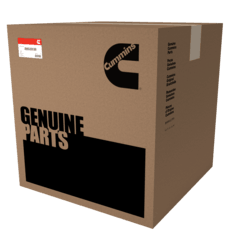This truck part is made by Cummins®. We guarantee that all of our parts are from the OEM (original equipment manufacturer), ensuring a proper fit and quality manufacturing.
We honor the warranty provided by the original equipment manufacturer.
Introduction To The Outlet Catalyst Module
The Outlet Catalyst Module, commonly known as an outlet catalyst, is a vital component in the exhaust system of commercial trucks. This part is instrumental in reducing harmful emissions by converting toxic gases into less harmful substances before they are released into the atmosphere 1. The Outlet Catalyst Module is essential for ensuring environmental compliance and maintaining the operational efficiency of commercial trucks.
The Role Of The Outlet Catalyst Module In Truck Engines
The primary function of the Outlet Catalyst Module is to treat exhaust gases from the engine. It contains a catalyst, typically composed of precious metals such as platinum, palladium, and rhodium, which facilitates chemical reactions that convert harmful pollutants into water vapor, carbon dioxide, and nitrogen 2. This process is crucial for meeting stringent emission standards and ensuring that trucks operate in an environmentally responsible manner.
How The Outlet Catalyst Module Works
The Outlet Catalyst Module operates by passing exhaust gases through a ceramic or metallic substrate coated with a catalyst. As the exhaust gases flow through the substrate, the catalyst promotes a series of exothermic reactions that convert carbon monoxide (CO), hydrocarbons (HC), and nitrogen oxides (NOx) into less harmful substances 3. This conversion is a critical step in reducing the environmental impact of truck emissions.
Importance Of The Outlet Catalyst Module In Truck Operations
For engineers, mechanics, and fleet operators, understanding the function and importance of the Outlet Catalyst Module is essential. This component not only helps in maintaining compliance with environmental regulations but also contributes to the overall efficiency and longevity of the engine 4. A well-functioning Outlet Catalyst Module ensures that the engine operates at optimal performance levels, reducing the risk of engine damage and costly repairs.
Troubleshooting The Outlet Catalyst Module
When this part begins to fail, it can lead to a variety of issues, including decreased engine performance, increased fuel consumption, and higher emissions. Common signs of a failing Outlet Catalyst Module include a decrease in power, a sulfur-like odor from the exhaust, and the illumination of the check engine light. If any of these symptoms are observed, it is important to conduct a thorough inspection and diagnostic testing to determine the condition of the Outlet Catalyst Module.
Maintenance Of The Outlet Catalyst Module
Regular maintenance of the Outlet Catalyst Module is essential to ensure its longevity and effectiveness. This includes routine inspections for physical damage, monitoring the condition of the catalyst substrate, and ensuring that the exhaust system is free from leaks. It is also important to use high-quality fuel and oil, as contaminants can accumulate in the Outlet Catalyst Module and reduce its efficiency.
Cummins: A Leader In Truck Engine Technology
Cummins is a renowned manufacturer of heavy-duty truck engines and related components, including the Outlet Catalyst Module. With a commitment to innovation and quality, Cummins has established itself as a leader in the industry. The company’s extensive research and development efforts have resulted in the production of reliable and efficient components that meet the demanding requirements of commercial truck operations 4.
Conclusion
As an expert in commercial truck parts, it is clear that the Outlet Catalyst Module is a critical component in the exhaust system of trucks. Understanding its function, importance, and maintenance requirements is essential for ensuring the environmental compliance and operational efficiency of commercial trucks. By providing comprehensive and detailed information about the Outlet Catalyst Module, this article aims to educate and inform engineers, mechanics, truck drivers, and fleet operators about the role of this component in truck engines.
References
-
Hilgers, Michael. Vocational Vehicles and Applications. Springer Nature, 2023.
↩ -
Brown Jr, Andrew. Technologies and Approaches to Reducing the Fuel Consumption of Medium and Heavy-Duty Vehicles. National Academy of Sciences, 2010.
↩ -
Reif, Konrad Ed. Fundamentals of Automotive and Engine Technology: Standard Drives, Hybrid Drives, Brakes, Safety Systems. Springer Vieweg, 2014.
↩ -
Cummins. Operation and Maintenance Manual for G8.3 CM558/CM2358. Bulletin Number 4021689.
↩ ↩
SPECIFICATIONS
RECOMMENDED PARTS
* Variable geometry turbocharger and electronic actuator repairs are not eligible to be claimed as over-the-counter under New or ReCon parts warranty for parts installed after October 1, 2018.
* Diesel Oxidation Catalyst (DOC), Diesel Particulate Filter (DPF), Selective Catalyst Reduction (SCR) catalyst, and Electronic Control Module (ECM) repairs are not eligible to be claimed as over-the-counter under New or ReCon parts warranty for parts installed after January 1, 2020.
* These restrictions are only applicable to New parts and ReCon parts coverages for the components listed above sold to a customer in the US or Canada. All other coverages are excluded. All other regions are excluded.

